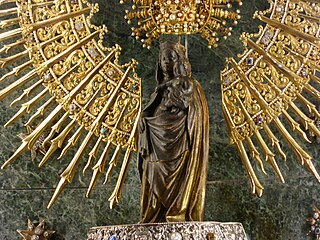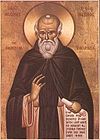Related Research Articles

The calendar of saints is the traditional Christian method of organizing a liturgical year by associating each day with one or more saints and referring to the day as the feast day or feast of said saint. The word "feast" in this context does not mean "a large meal, typically a celebratory one", but instead "an annual religious celebration, a day dedicated to a particular saint".
In the Catholic Church, holy days of obligation or precepts are days on which the faithful are expected to attend Mass, and engage in rest from work and recreation, according to the third commandment.

Our Lady of the Pillar is the name given to the Blessed Virgin Mary in the context of the traditional belief that Mary, while living in Jerusalem, supernaturally appeared to the Apostle James the Greater in AD 40 while he was preaching in what is now Spain. Those who adhere to this belief consider this appearance to be the only recorded instance of Mary exhibiting the mystical phenomenon of bilocation. Among Catholics, it is also considered the first Marian apparition, and unique because it happened while Mary was still living on Earth.

Aug. 31 - Eastern Orthodox liturgical calendar - Sep. 2

September 30 - Eastern Orthodox liturgical calendar - October 2

Our Lady of Aparecida, is a title of the Blessed Virgin Mary associated with the Immaculate Conception.
This article lists the feast days of the General Roman Calendar as they were at the end of 1954. It is essentially the same calendar established by Pope Pius X (1903–1914) following his liturgical reforms, but it also incorporates changes that were made by Pope Pius XI (1922–1939), such as the institution of the Feast of Christ the King, and the changes made by Pope Pius XII (1939–1958) prior to 1955, chief among them the imposition of the Feast of the Immaculate Heart of Mary upon the universal Church in 1944, the inscription of Pius X into the General Calendar following his 1954 canonization, and the institution of the Feast of the Queenship of Mary in October 1954.
The Church of England commemorates many of the same saints as those in the General Roman Calendar, mostly on the same days, but also commemorates various notable Christians who have not been canonised by Rome, with a particular though not exclusive emphasis on those of English origin. There are differences in the calendars of other churches of the Anglican Communion.
The General Roman Calendar is the liturgical calendar that indicates the dates of celebrations of saints and mysteries of the Lord in the Roman Rite of the Catholic Church, wherever this liturgical rite is in use. These celebrations are a fixed annual date, or occur on a particular day of the week. Examples are the Feast of the Baptism of the Lord in January and the Feast of Christ the King in November.

Prior to the revision of the Anglican Church of Canada's (ACC) Book of Common Prayer (BCP) in 1962, the national church followed the liturgical calendar of the 1918 Canadian Book of Common Prayer. Throughout most of the twentieth century, the situation in Canada resembled that which pertained in much of the Anglican Communion: There was uncertainty as to whether post-Reformation figures could or should be commemorated. In the words of the calendar's introduction, "New names have been added from the ancient calendars, and also from the history of the Anglican Communion, without thereby enrolling or commending such persons as saints of the Church." The 1962 revision added twenty-six post-Reformation individuals, as well as commemorations of the first General Synod and of "The Founders, Benefactors, and Missionaries of the Church in Canada." Of the calendar days, twenty-eight were highlighted as "red-letter days" — that is, days of required observation.
This is a calendar of saints list for the Armenian Apostolic Church.
The Tridentine calendar is the calendar of saints to be honoured in the course of the liturgical year in the official liturgy of the Roman Rite as reformed by Pope Pius V, implementing a decision of the Council of Trent, which entrusted the task to the Pope.
The ranking of liturgical days in the Roman Rite is a regulation for the liturgy of the Roman Catholic church. It determines for each liturgical day which observance has priority when liturgical dates and times coincide, which texts are used for the celebration of the Holy Mass and the Liturgy of the hours and which liturgical color is assigned to the day or celebration.
Mysterii Paschalis is an apostolic letter issued motu proprio by Pope Paul VI on 14 February 1969. It reorganized the liturgical year of the Roman Rite and revised the liturgical celebrations of Jesus Christ and the saints in the General Roman Calendar. It promulgated the General Roman Calendar of 1969.

December 1 - Eastern Orthodox liturgical calendar - December 3

December 9 - Eastern Orthodox liturgical calendar - December 11
In the Calendar of the Church in Wales, each holy and saint's day listed has been assigned a number which indicates its category. Commemorations not included in this Calendar may be observed with the approval of the bishop.
National calendars of the Roman Rite of the Catholic Church are lists of saints' feast days and other liturgical celebrations, organized by calendar date, that apply to those within the nation or nations to which each calendar applies who worship according to the Roman Rite of the Latin Church. Such calendars are "particular calendars" that build off of the General Roman Calendar. National calendars primarily add feast days of saints whose lives profoundly affected the particular nation in question, or whose veneration is especially prevalent there.
Institutional and societal calendars of the Roman Rite of the Catholic Church are lists of saints' feast days and other liturgical celebrations, organized by calendar date, that apply to members of individual institutes of consecrated life and societies of apostolic life of pontifical right that worship according to the Roman Rite of the Latin Church. They are "particular calendars" that build off of the General Roman Calendar.
References
- ↑ "Rubricarum instructum, Litterae Apostolicae Motu Proprio Datae Novum Rubricarum Breviarii et Missalis Romani Corpus approbatur, XXV Iulii MCMLX, Ioannes PP. XXIII | Ioannes XXIII". www.vatican.va. Retrieved 2022-09-22.
- ↑ Seasoltz, R. Kevin (1966). The new liturgy: a documentation, 1903-1965. Internet Archive. [New York] Herder and Herder.
- ↑ General decree Cum nostra of the Sacred Congregation of Rites
- 1 2 3 Acta Apostolicae Sedis LII (1960)
- ↑ "Decreto Cum sanctissima della Congregazione per la Dottrina della Fede circa la celebrazione liturgica in onore dei santi nella forma extraordinaria del Rito Romano, 25.03.2020". No. B0184. Holy See Press Office. Bolletino. March 25, 2020.
- ↑ DiPippo, Gregory (March 25, 2020). "New Prefaces and Feasts for the EF Missal". New Liturgical Movement.
- ↑ Kalendarium, Missale Romanum: "In anno bissextili mensis februarius est dierum 29, et festum S. Matthiae celebratur die 25 ac festum S. Gabrielis a Virgine Perdolente die 28 februarii, et bis dicitur Sexto Kalendas, id est die 24 et die 25; et littera dominicalis, quae assumpta fuit in mense ianuario, mutatur in praecedentem; ut, si in Januario, littera dominicalis fuerit A, mutetur in praecedentem, quae est g, etc.; et littera f bis servit, 24 et 25.
- ↑ Sancta Missa Ordo for use with the 1962 Missale Romanum. Chicago: Biretta Books. 2016. p. 9.
- ↑ Liturgical Ordo and FSSP Directory. Fraternity Publications Service. 2015. p. 12.Whenever the Mass of a saint in the universal calendar is taken from one of the Commons, a proper Mass of the same saint found in the appendix, Proprium Sanctorum pro Aliquibus Locis, may nowadays be used instead anywhere ad libitum [Rub.Gen. 305a].
- ↑ Missel Quotidien Saint-Joseph. New York: Catholic Book Publishing Co. 1960. p. 1253.

